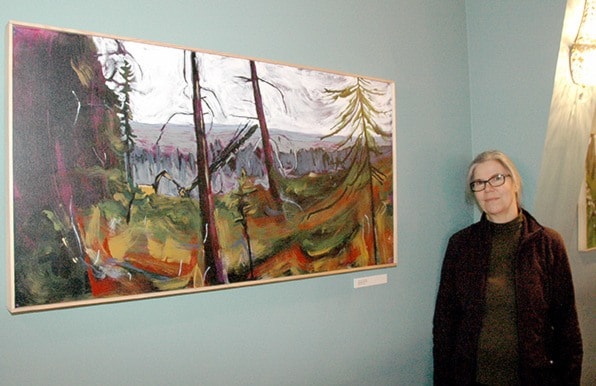Visiting royalty and heads of state housed in Victoria can now explore, through Vanderhoof and Prince George art, the beauty of forestry in northern B.C.
Starting this February, four of Vanderhoof artist Annerose Georgeson’s paintings that celebrate logging will be displayed for a year in the Government House of Victoria, as part of “A Raw and Northern View” exhibit showcasing work of three artists from northern B.C.
In Vanderhoof, the rest of Georgeson’s 16-painting series on logging — depicting scenes such as loading, hauling, and processing in styles at times likened to renowned B.C. painter Emily Carr — are on display in the Burrard Market Square for one month, after an opening reception on Apr. 15.
Curated by George Harris, artistic director and curator of Two Rivers Gallery in Prince George, the exhibit’s artwork were selected for their reflection of the northern B.C. reality, Harris explained.
“I thought it would be nice to focus on artwork that does not necessarily a romanticized version of the environment, but something that was familiar, more realistic, akin to our regular experiences with the wilderness or the forest,” he said.
In addition to Georgeson’s four paintings, the exhibit was comprised of paintings and sculptures from Prince George artists Allan Farmer and Phil Morrison respectively.
“In Prince George and Vanderhoof, as with many places, the forest surrounds us,” Harris said in his exhibit statement. “But here, where forestry and its related industries have an ubiquitous presence, if one is not employed directly in this sector one’s life is likely to intersect with it in other ways.
“In British Columbia, a province known for its natural beauty, our forests are a part of our identity which is often romanticized.
“The proximity of the forest, to these artists, and a working and dynamic forest industry, has influenced the way they see and reflect landscapes, forests and trees.”
In Farmer’s work, where pulp mills and waste stations are depicted, the matter-of-fact representations may seem out of the ordinary for those used to landscape paintings, Harris added.
“These are aspects of the landscape that typically you don’t tend to see, but they are indicative of our northern experience of land,” he said.
Development versus environment
For Georgeson, it was an honour for her paintings to be selected.
“I was shocked and very pleased,” she said. “It’s supposed to be somewhat representative of northern B.C., which is a great honour for me.”
Though she started her focus on logging two years ago, Georgeson has been producing art about forests for over 10 years and was inspired by the pine beetle epidemic that killed most of the pine trees in the province, she explained.
“There is a tension between love for the environment and industry; I think it’s possible for them to co-exist,” Georgeson stated. “The whole idea of logging seem destructive and sad to many people; in this area, it’s just business…what we do.
“All of my family has worked in the forest industry. Logging puts food on all our tables.”
She finds the tension interesting to explore, showing their own kind of beauty.
“Even in the most chaotic scenes on a cut-block where there’s just logging debris everywhere, new trees growing,” Georgeson said. “Artistically it’s still beautiful.”
Her strongest wish is for workers in the forestry industry to see the exhibit.
“I would really like them to see that art can celebrate their work.”
So far, she has heard mixed responses regarding the paintings on logging: for one attendee, the depiction was saddening, while another from the industry was taken back.
“He said, ‘that’s really what it’s like, that’s how it feels,’ and that makes me happier than anyone else,” Georgeson said. “That’s why I’m doing the art.”
For art enthusiast Monica Rach with a background in public art, the paintings convey a profound message.
“How often do you see abstract meetings of industry,” Rach said. “She’s depicting something that we don’t normally think of as art, or as valid of becoming art.”
For David Zurevinski, who works as a forester with B.C. Timber Sales and attended the opening reception with his wife Sonya, the paintings were very realistic.
“It’s abstract, but you look from a distance and it’s clear what it shows,” Zurevinski said. “Our favourite is [the one depicting] road building…it really takes you in.”
